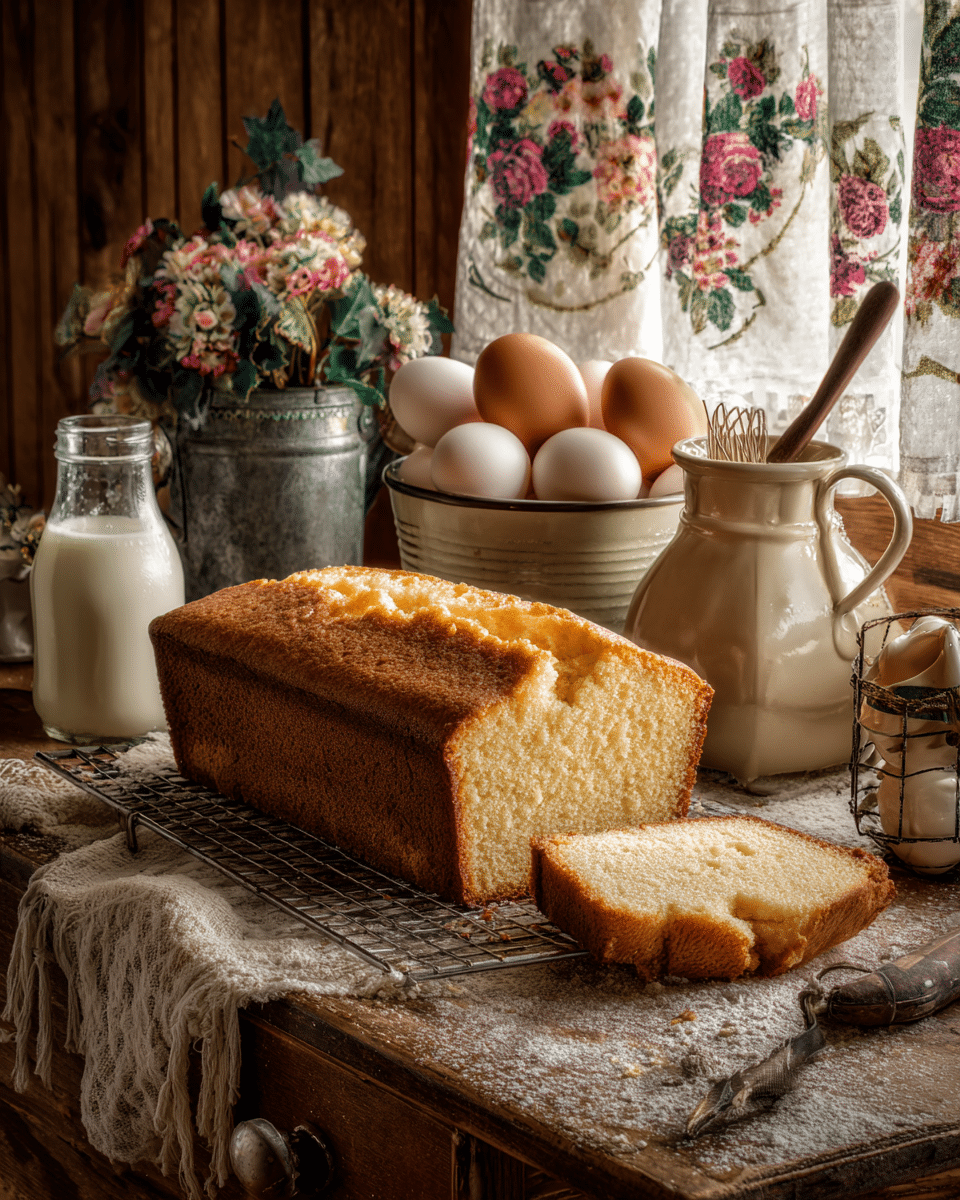This Old-Fashioned Pound Cake recipe is a cherished family heirloom that has been lovingly passed down through generations. Known for its rich, buttery flavor and dense yet tender crumb, it embodies the simple baking traditions of the past. Whether served plain, dusted with powdered sugar, or topped with fresh fruit and whipped cream, this classic pound cake never fails to bring a touch of nostalgia and comfort to any occasion.
FULL RECIPE
Ingredients
- 1 cup (226 g) unsalted butter, softened
- 2 cups (400 g) granulated sugar
- 4 large eggs, room temperature
- 3 cups (360 g) all-purpose flour
- 1 teaspoon baking powder
- ½ teaspoon salt
- 1 cup (240 ml) whole milk, room temperature
- 2 teaspoons pure vanilla extract
Directions
- Preheat your oven to 325°F (163°C). Grease and flour a 10-inch (25 cm) bundt or tube pan.
- In a large bowl, cream together the softened butter and granulated sugar until light and fluffy, about 4–5 minutes.
- Add the eggs one at a time, beating well after each addition to fully incorporate.
- In a separate bowl, whisk together the all-purpose flour, baking powder, and salt.
- Gradually add the dry ingredients to the creamed mixture alternately with the milk, starting and ending with the dry ingredients. Mix just until combined; do not overmix.
- Stir in the vanilla extract until evenly distributed throughout the batter.
- Pour the batter into the prepared pan and smooth the top with a spatula.
- Bake in the preheated oven for 60–75 minutes, or until a toothpick inserted into the center comes out clean.
- Allow the cake to cool in the pan for about 15 minutes, then carefully remove it from the pan and transfer to a wire rack to cool completely.
- Slice and serve as desired. Enjoy the rich, buttery goodness passed down from grandma!
Nutrition Facts
- Serving Size: 1 slice (1/12 of cake)
- Calories: 380
- Total Fat: 17 g
- Saturated Fat: 10 g
- Cholesterol: 105 mg
- Sodium: 200 mg
- Total Carbohydrates: 52 g
- Dietary Fiber: 1 g
- Sugars: 30 g
- Protein: 6 g
History and Tradition of Pound Cake
The pound cake has a rich history dating back to the 18th century when it was named for its original recipe: one pound each of butter, sugar, eggs, and flour. This simple formula made it easy for home bakers to remember and prepare. Passed down through generations, the cake became a staple in many households, often baked for special occasions and family gatherings. Its enduring popularity is a testament to its timeless flavor and comforting texture.
Texture and Flavor Profile
Old-fashioned pound cake is celebrated for its dense yet moist crumb and rich buttery flavor. Unlike lighter cakes that rely heavily on chemical leaveners, this cake’s texture is more substantial due to the balance of ingredients and the creaming method. The slight sweetness and subtle vanilla notes make it versatile, allowing it to pair well with a variety of toppings and accompaniments without overpowering them.
Health Considerations
While pound cake is a delicious treat, it is high in calories, saturated fats, and sugars due to its traditional ingredients. It is best enjoyed in moderation as part of a balanced diet. For those monitoring cholesterol or sugar intake, occasional indulgence is fine, but it’s important to be mindful of portion size. The cake does provide some protein from eggs and calcium from milk, though these benefits are outweighed by the richness of the cake.
Variations and Flavor Enhancements
The classic pound cake recipe lends itself well to numerous variations. Some bakers like to add citrus zest, such as lemon or orange, to brighten the flavor. Others incorporate spices like cinnamon or nutmeg for warmth. Swirling in berries, chocolate chips, or nuts can add texture and bursts of flavor. For a modern twist, some replace part of the butter with cream cheese to increase moisture and add tanginess.
Serving Suggestions
Pound cake can be served in many delightful ways beyond a simple slice. It pairs beautifully with fresh berries and whipped cream for a light dessert. A drizzle of chocolate or caramel sauce can elevate it into a more decadent treat. Toasted pound cake slices also work well as a base for ice cream or fruit compotes. Warmed slightly, it’s perfect with a cup of tea or coffee for an indulgent afternoon snack.
Pairing with Beverages
When it comes to beverages, pound cake’s buttery richness complements both hot and cold drinks. Classic pairings include coffee and black tea, which help balance the cake’s sweetness. For an adult twist, serving it with dessert wines like Moscato or a sweet sherry can add elegance. Even sparkling water with a splash of citrus can be refreshing alongside a slice, cleansing the palate between bites.
Storage Tips for Freshness
To keep pound cake fresh and moist, it should be stored properly. Wrap the cooled cake tightly in plastic wrap or aluminum foil to prevent it from drying out. It can be kept at room temperature for up to three days or refrigerated for up to a week. For longer storage, pound cake freezes well when wrapped securely and placed in an airtight container, retaining its flavor and texture for up to three months.
Reheating and Serving Leftovers
Leftover pound cake can be revitalized with gentle reheating. Briefly warming slices in the microwave or oven enhances the cake’s softness and aroma. Toasting leftover slices is another excellent option, giving the cake a crispy edge while keeping the inside tender. Using leftover pound cake in recipes such as bread pudding or trifles is a delicious way to enjoy it with a new twist.
Cultural Impact and Popularity
Pound cake remains a beloved dessert across many cultures, especially in the United States and Europe, where it is often associated with comfort and hospitality. Its simple ingredients and straightforward preparation have made it a favorite in both home kitchens and bakeries. The cake’s nostalgic value also connects people to family traditions and memories, making it more than just a dessert but a symbol of heritage.
Baking Tips for Success
Achieving the perfect pound cake requires attention to detail. Using room temperature ingredients ensures proper creaming and smooth batter. Avoiding overmixing preserves the cake’s tender crumb. The baking temperature is crucial; too high can dry out the cake, while too low may lead to undercooking. Patience in cooling the cake before slicing helps maintain its shape and texture.
Conclusion
The old-fashioned pound cake is more than just a dessert; it is a comforting piece of culinary history that has stood the test of time. Its rich flavor, dense texture, and versatility make it an enduring favorite for families and bakers alike. Whether enjoyed plain or enhanced with various toppings and pairings, this classic cake continues to bring warmth and nostalgia to the table, embodying the essence of traditional home baking.






